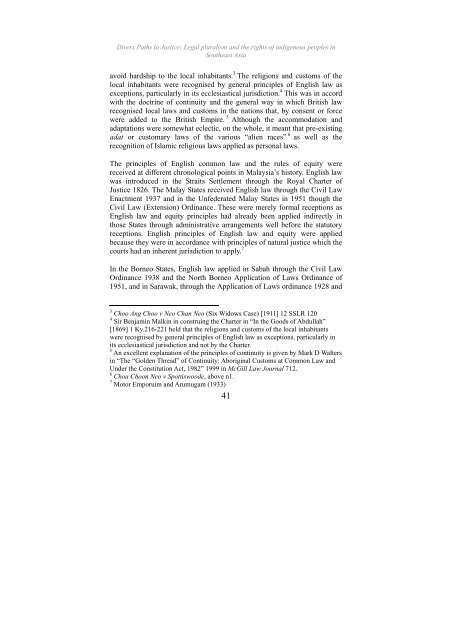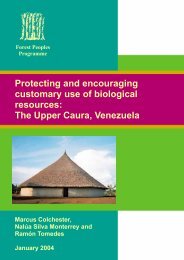Divers Paths to Justice - English - Forest Peoples Programme
Divers Paths to Justice - English - Forest Peoples Programme
Divers Paths to Justice - English - Forest Peoples Programme
You also want an ePaper? Increase the reach of your titles
YUMPU automatically turns print PDFs into web optimized ePapers that Google loves.
<strong>Divers</strong> <strong>Paths</strong> <strong>to</strong> <strong>Justice</strong>: Legal pluralism and the rights of indigenous peoples inSoutheast Asiaavoid hardship <strong>to</strong> the local inhabitants. 3 The religions and cus<strong>to</strong>ms of thelocal inhabitants were recognised by general principles of <strong>English</strong> law asexceptions, particularly in its ecclesiastical jurisdiction. 4 This was in accordwith the doctrine of continuity and the general way in which British lawrecognised local laws and cus<strong>to</strong>ms in the nations that, by consent or forcewere added <strong>to</strong> the British Empire. 5 Although the accommodation andadaptations were somewhat eclectic, on the whole, it meant that pre-existingadat or cus<strong>to</strong>mary laws of the various “alien races” 6 as well as therecognition of Islamic religious laws applied as personal laws.The principles of <strong>English</strong> common law and the rules of equity werereceived at different chronological points in Malaysia’s his<strong>to</strong>ry. <strong>English</strong> lawwas introduced in the Straits Settlement through the Royal Charter of<strong>Justice</strong> 1826. The Malay States received <strong>English</strong> law through the Civil LawEnactment 1937 and in the Unfederated Malay States in 1951 though theCivil Law (Extension) Ordinance. These were merely formal receptions as<strong>English</strong> law and equity principles had already been applied indirectly inthose States through administrative arrangements well before the statu<strong>to</strong>ryreceptions. <strong>English</strong> principles of <strong>English</strong> law and equity were appliedbecause they were in accordance with principles of natural justice which thecourts had an inherent jurisdiction <strong>to</strong> apply. 7In the Borneo States, <strong>English</strong> law applied in Sabah through the Civil LawOrdinance 1938 and the North Borneo Application of Laws Ordinance of1951, and in Sarawak, through the Application of Laws ordinance 1928 and3 Choo Ang Choo v Neo Chan Neo (Six Widows Case) [1911] 12 SSLR 1204 Sir Benjamin Malkin in construing the Charter in “In the Goods of Abdullah”[1869] 1 Ky.216-221 held that the religions and cus<strong>to</strong>ms of the local inhabitantswere recognised by general principles of <strong>English</strong> law as exceptions, particularly inits ecclesiastical jurisdiction and not by the Charter.5 An excellent explanation of the principles of continuity is given by Mark D Waltersin “The “Golden Thread” of Continuity: Aboriginal Cus<strong>to</strong>ms at Common Law andUnder the Constitution Act, 1982” 1999 in McGill Law Journal 712.6 Choa Choon Neo v Spottiswoode, above n1.7 Mo<strong>to</strong>r Emporuim and Arumugam (1933)41
















